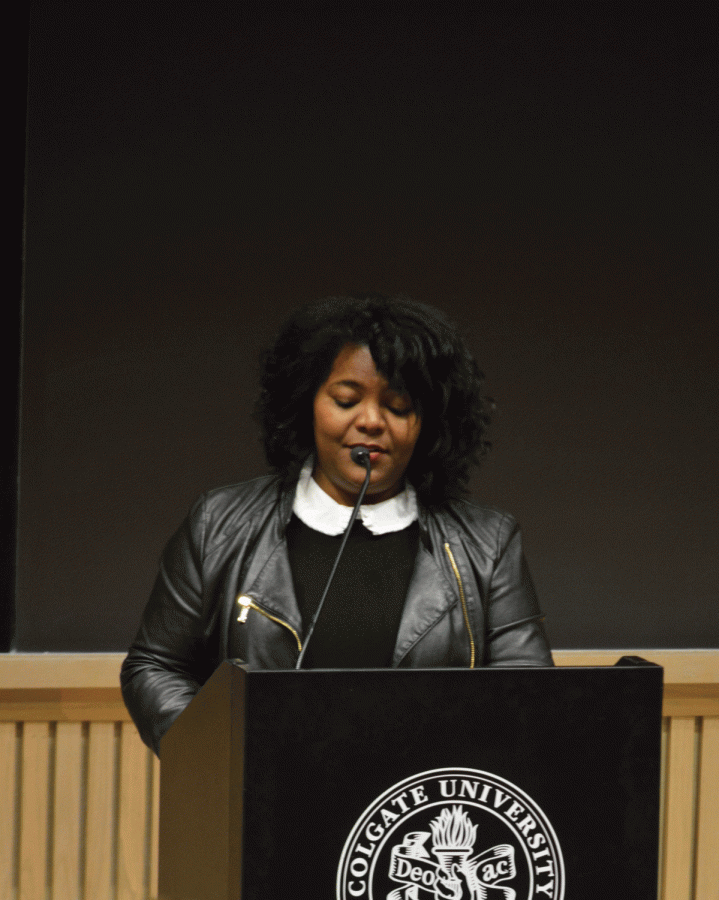A New Take on an Old Classic: The Great Gatsby Revisited
On Thursday, November 9, award-winning author Stephanie Powell Watts came to Love Auditorium as a continuation of the Living Writers Series. Associate Professor of English Jennifer Brice introduced Watts with a quick summary of Watts’ featured novel, No One Is Coming to Save Us. Inspired by F. Scott Fitzgerald’s The Great Gatsby, Watts’ novel focuses on a contemporary African American family in a struggling town in North Carolina. Brice summarized Watts’ achievements, which include winning the Whiting Award and the Earnest J. Gaines Award for Literary Excellence for her other work, We Are Taking Only What We Need.
Watts began by engaging the audience in a discussion about The Great Gatsby. She asked the audience which parts of The Great Gatsby were the most memorable to them. Many recalled the famous party scenes and the lavish lifestyles depicted in the text, but few mentioned what was particularly notable for Watts. She explained that, to her, the most memorable part of The Great Gatsby was the absence of female opinion and voice, and a lack of characters of color. When she started writing her novel, No One Is Coming to Save Us, her main thought was, “What would the women say?”
Another inspiration for Watts was the deep sense of nostalgia in The Great Gatsby. She spoke about the theme of looking to the past, and articulated the importance of retrospection. In her opinion, the only way to move past hard times is to look back on them and examine them. Only then can you learn from the troubles you have had and move forward. This type of nostalgia, though more difficult than simply looking back on all of the positive memories, ultimately leads to closure in the present. In her own novel, Watts focuses on this theme of retrospection.
After the initial discussion of Fitzgerald’s classic, Watts read an excerpt from the beginning of her book. The detailed opening scenes came alive as Watts described the rich part of a town, discussing the feeling of isolation felt by a family driving past as they looked into the brightly lit windows of beautiful houses. Though they live in the same town and shop at the same stores, the poorer family’s sense of isolation is piercing and ever-present. This first portion of the novel also gave the audience a quick introduction to some of the main characters. The beginning was so gripping that, if someone had not read the novel yet, they would certainly want to after hearing Watts’ oration.
Watts again turned to the audience, this time to answer their questions. Many people asked Watts about the inspiration behind her characters. Watts explained that she wanted to portray people as they were when she was growing up in North Carolina. She did so by including small moments of southern culture that can only truly be understood by the native residents of the south, such as superstitions and idioms not usually understood by strangers.
Watts was asked why readers were not given much entry into the mind of her “Gatsby”-like character, JJ Ferguson. Watts responded by explaining that she wanted to give the female characters in her novel the main voices. As a response to the male-dominated Gatsby, Watts decided to center her novel around female characters, giving readers a look into their minds instead of offering a male-dominated narrative by looking through the mind of JJ.
“In many important ways, this is not JJ’s story,” Watts said.
Watts, an African American woman, felt like she couldn’t find an entrance into Fitzgerald’s novel, so she decided to create her own. She also focused on creating characters that didn’t always know the “right” thing to do. Watts discussed how, when children are growing up, they are often given books to read about astounding people who somehow always know what to do so that these children could look up to them as role models, but at some point, Watts realized that it is just as important to look up to someone who is imperfect. Children need to learn that it isn’t always necessary to fit in; being yourself is enough. By introducing characters who experience identity crises, Watts was able to send this message.
By the end of the question-and-answer session, only a fraction of the depth and meaning in Watts’ book was realized, but this just made audience members that had not yet read her novel want to read it even more. The deep themes of gender, race, social class and simple humanity resonated with everyone in attendance, and the grace with which Watts was able to discuss these important themes was astounding.
Contact Sasha Balasanov at [email protected].







